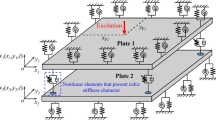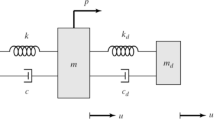Abstract
A tall building comprised of tubular frame, central shear core, and outrigger-belt truss systems is considered as an equivalent flexural hollow box beam with lumped masses at each floor level. Natural frequencies and mode shapes of the un-damped hybrid system are obtained by forming mass and stiffness matrices and solving the eigenvalue problem. Previous researches did not deal with the overall intrinsic damping of the structure or the damping added by external instruments, nor they considered the hybrid structure comprised of a tubular frame with geometrical discontinuous and damped outrigger systems in free vibration studies. By utilizing the achieved frequencies, first to fifth mode shape vectors, mass matrix, and modal participant mass and considering 5% modal damping ratio for each mode, the classically damping matrix of the hybrid system is achieved to fill these gaps. Then the non-classical damping matrix of the hybrid system with damped outriggers is obtained by adding the viscosity of passive linear viscous dampers to the classical damping matrix at the level of damped outrigger-belt truss systems. The eigenvalue problem is solved, and natural frequencies and mode shapes are obtained. 3-D finite element models of two 60- and 70-story buildings with conventional and damped outrigger systems are analyzed, and comparing the results of the proposed method and those of SAP2000 models reveals the correctness, reliability, and robustness of the method. Moreover, calculating natural frequencies by the proposed method is much less time consuming in comparison with finite element models.
















Similar content being viewed by others
References
Ghasemzadeh H, Rahmani Samani HR (2010) Estimating frequency of vibration for tubular tall buildings. In: 14th European Conference on Earthquake Engineering Ohrid, Republic of Macedonia
Mahjoub R, Rahgozar R, Saffari H (2011) Simple method for analysis of tube frame by consideration of negative shear lag. Aust J Basic Apply Sci 5(3):309–316
Jahanshahi MR, Rahgozar R, Malekinejad M (2012) A simple approach to static analysis of tall buildings with a combined tube-in-tube and outrigger-belt truss system subjected to lateral loading. Int J Eng IJE 25(3):289–299
Taranath BS (2017) Tall building design, steel, concrete, and composite systems. Taylor & Francis, London, England
Malekinejad M, Rahgozar R (2012) A simple analytical method for computing the natural frequencies and mode shapes of tall buildings. J App Math Modell 36(8):3419–3432
Kamgar R, Saadatpour MM (2012) A Simple mathematical model for free vibration analysis of combined system consisting of framed tube, Shear core, belt truss and outrigger system with geometrical discontinuities. J App Math Modell 36(10):4918–4930
Malekinejad M, Rahgozar R, Malekinejad A, Rahgozar P (2016) A continuous–discrete approach for evaluation of natural frequencies and mode shapes of high-rise buildings. Int J Adv Struct Eng 8(3):269–280
Mohammadnejad M, Haji Kazemi H (2017) Dynamic response analysis of a combined system of framed tubed, shear core and outrigger-belt truss. Asian J Civ Eng 18:1211–1228
Mohammadnejad M, Haji Kazemi H (2018) A new and simple analytical approach to determining the natural frequencies of framed tube structures. J Struct Eng Mech 65(1):111–120
Rahgozar P (2020) Free vibration of tall buildings using energy method and Hamilton’s principle. J Civ Eng 6(5):945–953
Kwan AKH (1994) Simple method for approximate analysis of framed tube structures. J Struct Eng ASCE 120(4):1221–1239
Kamgar R, Rahgozar P (2020) Optimum location for the belt truss system for minimum roof displacement of steel buildings subjected to critical excitation. Steel Compos Struct J. Techno-Press. 37(4):463–479. https://doi.org/10.12989/scs.2020.37.4.000
Alavi A, Rahgozar P, Rahgozar R (2018) Minimum-weight design of high-rise structures subjected to flexural vibration at a desired natural frequency. J Struct Des Tall Spec Build 27(15):e1515. https://doi.org/10.1002/tal.1515
Smith RJ, Willford MR (2007) The damped outrigger concept for tall buildings. J Struct Des Tall Spec Build 16:501–517
Khatibinia M, Gholami H, Kamgar R (2018) Optimal design of tuned mass dampers subjected to continuous stationary critical excitation. Int J Dyn Control 6(3):1094–1104
Chen Y, McFarland DM, Wang Z, Spencer BF, Bergman LA (2010) Analysis of tall buildings with damped outriggers. J Struct Eng ASCE 136:1435–1443
Chen Y, Zhang Z (2018) Analysis of outrigger numbers and locations in outrigger braced structures using a multi objective genetic algorithm. Struct Des Tall Spec Build 27(1):e1408
Huang B, Takeuchi T (2017) Dynamic response evaluation of damped-outrigger systems with various heights. J Earthq Spectra 33(2):665–685
Rostami S, Shojaee S (2017) Alpha-modification of cubic B-Spline direct time integration method. Int J Struct Stab Dyn 17(10):1750118
Rostami S, Shojaee S (2018) A family of cubic B-spline direct integration algorithms with controllable numerical dissipation and dispersion for structural dynamics. Iran J Sci Technol Trans Civ Eng 42(1):17–32
Kamgar R, Rahgozar P (2019) Reducing static roof displacement and axial forces of columns in tall buildings based on obtaining the best locations for multi-rigid belt truss outrigger systems. Asian J Civ Eng 20(6):759–768. https://doi.org/10.1007/s42107-019-00142-0
Tavakoli R, Kamgar R, Rahgozar R (2018) The best location of belt truss system in tall buildings using multiple criteria subjected to blast loading. Civ Eng J 4(6):1338–1353
Davari SM, Malekinejad M, Rahgozar R (2019) Static analysis of tall buildings based on Timoshenko beam theory. Int J Adv Struct Eng 11:455–461. https://doi.org/10.1007/s40091-019-00245-7
Tavakoli R, Kamgar R, Rahgozar R (2019) Seismic performance of outrigger-braced system based on finite element and component-mode synthesis methods. Iran J Sci Technol Trans Civ Eng. https://doi.org/10.1007/s40996-019-00299-3
Amini M, Akbarpour A, Haji Kazemi H, Adibramezani M (2021) Mathematical formulation for determining lateral displacement of tubular frame and outriggers equipped with viscous dampers. Int J Integr Eng 13(1):201–217. https://doi.org/10.30880/ijie.2021.13.01.018
Takabatake H, Kitada Y, Takewaki I, Kishida A (2019) Simplified dynamic analysis of high-rise buildings. Springer, Singapore
Simiu E, Yeo D (2019) Wind effects on structures. Wiley, NJ, USA
Davari SM, Malekinejad M, Rahgozar R (2021) An approximate approach for the natural frequencies of tall building with trussed-tube system. Innov Infrastruct Solut 6(2):1–9. https://doi.org/10.1007/s41062-020-00418-4
Alavi A, Mele E, Rahgozar R, Noroozinejad Farsangi E, Takewaki I, Málaga-Chuquitaype C (2021) Uniform deformation design of outrigger braced skyscrapers: a simplified method for the preliminary design stage. J Struct 31:395–405. https://doi.org/10.1016/j.istruc.2021.01.099
Tavakoli R, Kamgar R, Rahgozar R (2020) Optimal location of energy dissipation outrigger in high-rise building considering nonlinear soil-structure Interaction effects. Period Polytech Civ Eng 64(3):887–903. https://doi.org/10.3311/PPci.14673
Babaei M, Mohammadi Y, Ghannadiasl A (2021) Calculation of vibration period of tall pyramidal buildings structures with tube systems, tube-in-tube, bundled tube and hybrid tube systems with shear wall. Iran J Sci Technol Trans Civ Eng. https://doi.org/10.1007/s40996-021-00688-7
Husain M, Hassan H, Mohamed HA, Elgharbawy ES (2021) The seismic response of structural outrigger systems in the tall buildings. J Appl Eng Sci. https://doi.org/10.5937/jaes0-30837
Babaei M, Mohammadi Y, Ghannadiasl A (2021) Free vibration and frequency calculation in tall buildings with stepped tube-in-tube systems. Int J Acoust Vib 26(2):140–146. https://doi.org/10.20855/ijav.2021.26.21752
Choi H, Ho G, Joseph L, Mathias N (2012) Outrigger design for high-rise buildings. CTBUH Outrigger working group, Council on Tall Building and Urban Habitat, Chicago, USA
Chopra AK (2012) Dynamic of structures. Prentice Hall, Berkeley, California
Abdel Raheem SE (2014) Dynamic characteristics of hybrid tower of cable-stayed bridges. J Steel Compos Struct 17(6):803–824. https://doi.org/10.12989/scs.2014.17.6.803
Matlab (2009) Mathworks Inc. Version 7.9.0529, USA
ASCE/SEI 07 (2017), Minimum design loads and associated criteria for buildings and other structures. American Society of Civil Engineers, ASCE, Virginia, USA
Hutchinson JR (2001) Shear coefficients for Timoshenko beam theory. J Appl Mech 68(1):87–92. https://doi.org/10.1115/1.1349417
ECS (2004) Eurocode 8 - design of structures for earthquake resistance. Part 1: general rules, seismic actions and rules for buildings. EN1998-1. European Committee for Standardization, Brussels.
International Conference of Building Officials (1997), Uniform Building Code, International Conference of Building Officials, Pasadena, CA
NBCC (2015) National building code of Canada, Canadian Commission on Building and Fire Codes, National Research Council of Canada (NRCC), Ottawa, Canada
Abdel Raheem SE (2013) Evaluation of Egyptian code provisions for seismic design of moment-resisting-frame multi-story buildings. Int J Adv Struct Eng. https://doi.org/10.1186/2008-6695-5-20
Author information
Authors and Affiliations
Corresponding author
Ethics declarations
Conflicts of interest
There is no conflict of interest on behalf of all authors.
Rights and permissions
About this article
Cite this article
Amini, M., Akbarpour, A., Haji Kazemi, H. et al. An innovative approach for evaluating mode shapes and natural frequencies of tubular frame and damped outriggers. Innov. Infrastruct. Solut. 7, 33 (2022). https://doi.org/10.1007/s41062-021-00634-6
Received:
Accepted:
Published:
DOI: https://doi.org/10.1007/s41062-021-00634-6




